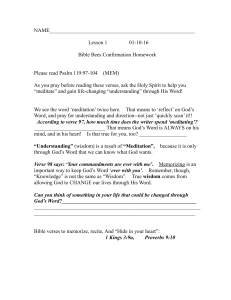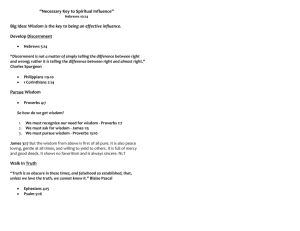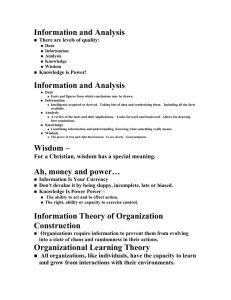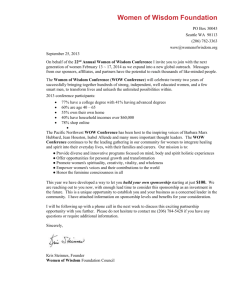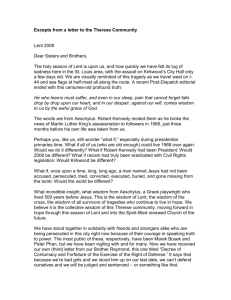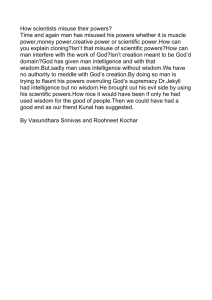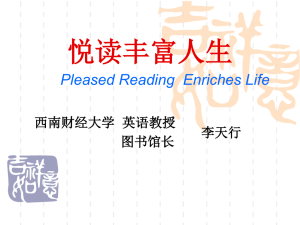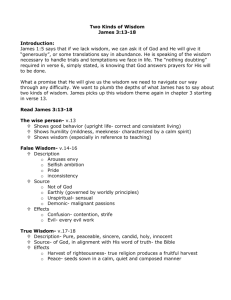The Bell and the Dorje
advertisement
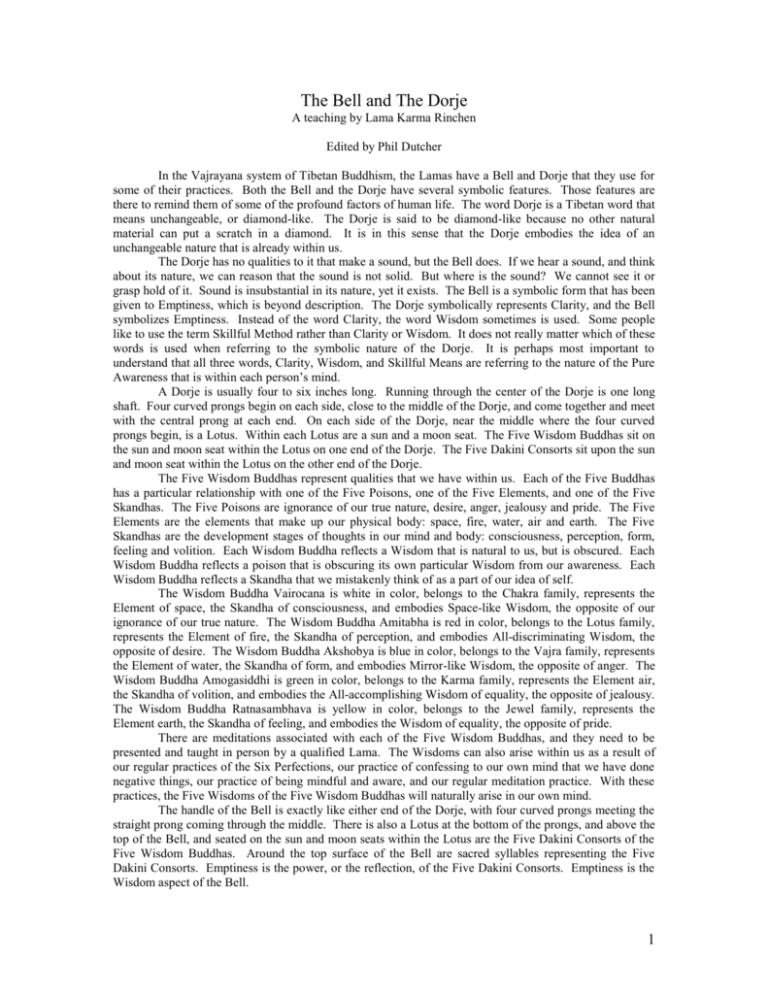
The Bell and The Dorje A teaching by Lama Karma Rinchen Edited by Phil Dutcher In the Vajrayana system of Tibetan Buddhism, the Lamas have a Bell and Dorje that they use for some of their practices. Both the Bell and the Dorje have several symbolic features. Those features are there to remind them of some of the profound factors of human life. The word Dorje is a Tibetan word that means unchangeable, or diamond-like. The Dorje is said to be diamond-like because no other natural material can put a scratch in a diamond. It is in this sense that the Dorje embodies the idea of an unchangeable nature that is already within us. The Dorje has no qualities to it that make a sound, but the Bell does. If we hear a sound, and think about its nature, we can reason that the sound is not solid. But where is the sound? We cannot see it or grasp hold of it. Sound is insubstantial in its nature, yet it exists. The Bell is a symbolic form that has been given to Emptiness, which is beyond description. The Dorje symbolically represents Clarity, and the Bell symbolizes Emptiness. Instead of the word Clarity, the word Wisdom sometimes is used. Some people like to use the term Skillful Method rather than Clarity or Wisdom. It does not really matter which of these words is used when referring to the symbolic nature of the Dorje. It is perhaps most important to understand that all three words, Clarity, Wisdom, and Skillful Means are referring to the nature of the Pure Awareness that is within each person’s mind. A Dorje is usually four to six inches long. Running through the center of the Dorje is one long shaft. Four curved prongs begin on each side, close to the middle of the Dorje, and come together and meet with the central prong at each end. On each side of the Dorje, near the middle where the four curved prongs begin, is a Lotus. Within each Lotus are a sun and a moon seat. The Five Wisdom Buddhas sit on the sun and moon seat within the Lotus on one end of the Dorje. The Five Dakini Consorts sit upon the sun and moon seat within the Lotus on the other end of the Dorje. The Five Wisdom Buddhas represent qualities that we have within us. Each of the Five Buddhas has a particular relationship with one of the Five Poisons, one of the Five Elements, and one of the Five Skandhas. The Five Poisons are ignorance of our true nature, desire, anger, jealousy and pride. The Five Elements are the elements that make up our physical body: space, fire, water, air and earth. The Five Skandhas are the development stages of thoughts in our mind and body: consciousness, perception, form, feeling and volition. Each Wisdom Buddha reflects a Wisdom that is natural to us, but is obscured. Each Wisdom Buddha reflects a poison that is obscuring its own particular Wisdom from our awareness. Each Wisdom Buddha reflects a Skandha that we mistakenly think of as a part of our idea of self. The Wisdom Buddha Vairocana is white in color, belongs to the Chakra family, represents the Element of space, the Skandha of consciousness, and embodies Space-like Wisdom, the opposite of our ignorance of our true nature. The Wisdom Buddha Amitabha is red in color, belongs to the Lotus family, represents the Element of fire, the Skandha of perception, and embodies All-discriminating Wisdom, the opposite of desire. The Wisdom Buddha Akshobya is blue in color, belongs to the Vajra family, represents the Element of water, the Skandha of form, and embodies Mirror-like Wisdom, the opposite of anger. The Wisdom Buddha Amogasiddhi is green in color, belongs to the Karma family, represents the Element air, the Skandha of volition, and embodies the All-accomplishing Wisdom of equality, the opposite of jealousy. The Wisdom Buddha Ratnasambhava is yellow in color, belongs to the Jewel family, represents the Element earth, the Skandha of feeling, and embodies the Wisdom of equality, the opposite of pride. There are meditations associated with each of the Five Wisdom Buddhas, and they need to be presented and taught in person by a qualified Lama. The Wisdoms can also arise within us as a result of our regular practices of the Six Perfections, our practice of confessing to our own mind that we have done negative things, our practice of being mindful and aware, and our regular meditation practice. With these practices, the Five Wisdoms of the Five Wisdom Buddhas will naturally arise in our own mind. The handle of the Bell is exactly like either end of the Dorje, with four curved prongs meeting the straight prong coming through the middle. There is also a Lotus at the bottom of the prongs, and above the top of the Bell, and seated on the sun and moon seats within the Lotus are the Five Dakini Consorts of the Five Wisdom Buddhas. Around the top surface of the Bell are sacred syllables representing the Five Dakini Consorts. Emptiness is the power, or the reflection, of the Five Dakini Consorts. Emptiness is the Wisdom aspect of the Bell. 1 If we look closely at a representation of Dorje Chang, who is known as Vajradhara in the Sanskrit language, we will see that he is holding a Dorje in one hand, and a Bell in the other, and his arms are crossed in front of him This symbolizes his embracing the union of Clarity, or Clear Light, and Emptiness. There is much more that can be said about the Bell and Dorje; this is just the essence of what they symbolize. Most importantly, how do we now put this information to use as we work toward enlightenment? The answer to that question is that we work hard on our meditation practice and continue to dig ever deeper and deeper into the meanings of the Buddha’s teachings. We have the relative world that we have grown up in and have become accustomed to. We believe that everything around us is real and solid. Then we hear these Buddhist teachings about Emptiness and everything around us being an Illusion. How do we explain and understand ideas that are so different from our experience? If we can sufficiently calm our mind by using meditation techniques, we will be able to have some realizations of the activity of our mind that will take away some of the strength of the habits and tendencies that are pretending to be us. The Vajrayana tradition is full of methods that can help us recognize the activities of our mind. If we commit to the Vajrayana training methods, we can make positive imprints on our mind as we go about our daily life. This will be of tremendous help to us when we begin to look for the nature of the Illusion. Even if our mind practice is at the beginning level of mindfulness, even then, from day to day, we are paying attention to the habits of our mind, and this will help us discover some of the tricks of the Illusion. All thoughts arise out of the empty nature of our mind, pushed up by our collection of habits and tendencies, not only those of this life, but also habits and tendencies from countless lives before this one. Over time our habits and tendencies have gained such strength and power in our mind that they are all that we know. We think that the thoughts arising from our habits and tendencies are who we are, our permanent self. But these arising thoughts are not our own true nature. The reality is that these arising thoughts are obscuring our own true nature. From the ultimate view, they are the Illusion. Those practitioners who have genuinely experienced the ultimate level of mind tell us that the experience that we have with our senses is similar to that which we have with a mirror. If we look in a mirror, and think that what we see has a substantial reality, it should mean that we should also be able to reach out with our fingers and grasp the image. But we cannot do that. A thought that the image is real and graspable is an Illusion. As intelligent beings we know that the image of our face in the mirror is a reflection, and does not have a physical reality that is different from the reflection. This analogy of the mirror is used to explain the difference between the relative and ultimate views. When we think that what we see with our eyes, smell with our nose, hear with our ears, or touch with our hands has a substantial reality, we are experiencing the relative view. From the ultimate perspective, those thoughts are the Illusion. This is the essence of the meaning of the illusion right here. It is not easy to see through the Illusions of the relative mind, or to have the pure awareness of the ultimate mind. However, we should not become discouraged if these teachings about the Illusion confuse us. We are very fortunate to have even come across these teachings. We should use these teachings as a challenge to awaken a need for understanding and truly realizing the meanings. We begin training in meditation practice with Shinay meditation, the meditation to calm our mind. It is important for both our mind and body to be relaxed when we meditate. There is a seven-point meditation posture that is taught: legs crossed in the Vajra asana; hands placed four fingers below the navel; right hand resting in the left; back straight as an arrow; shoulders pulled back; chin slightly tucked in and eyes half open. Our mind is what we are really working on with meditation, so we should not get discouraged if we cannot sit in the proper way. All meditation practices are mind training, and it is most important for our mind and body to be relaxed when we meditate. Sitting in a chair or walking while we meditate is okay. In the process of our meditation practice, if it only makes sense to us that there is something substantial in our mind, we should examine this idea thoroughly and try to prove it. We can also look and see if we can find something other than what we think is there. All of the Buddhas and Bodhisattvas, in all of the aeons, have never seen or found anything substantial in their minds, even with their fully enlightened minds. All of the meditations and other Dharma practices are for finding out what it is that we see in our mind. Many students have told me that, when they are meditating, that they have reached a state of no thought, when their thoughts are completely gone. That kind of experience is a misunderstanding of the nature of the mind. We have to understand that thoughts are never gone. When our desire to have progress 2 in our meditation and other mind practices is strong, our habits and tendencies can play these kind of trick ideas on us.. Our thoughts just go on and on. If we have a dream while we are sleeping, the dream is created by our thoughts. Our mental body continues to be active even after we have been buried or cremated, and our thoughts continue to arise after our death. Our thoughts never stop. From the condition that our mind is in after death, while we are in the Bardo, our thoughts create the experiences of hell beings, hungry ghosts, and so forth. All Bardo experiences are our thoughts, still going. Also, we can have an ego that is so strong that our efforts with meditation are wasted. We have to be careful that we follow all of the methods correctly, and learn what the true nature of the activity of our mind really is. We need to find good clear instruction, and develop faith and confidence in it. Our Dharma practice needs to be correctly put together so that the conditions are good for spiritual development and realization. Lama Tempa and I invite you to come to Kagyu Thegchen Ling and ask us questions about correct ways to meditate. You are welcome to do so at any time that we are there. Skilful 3
